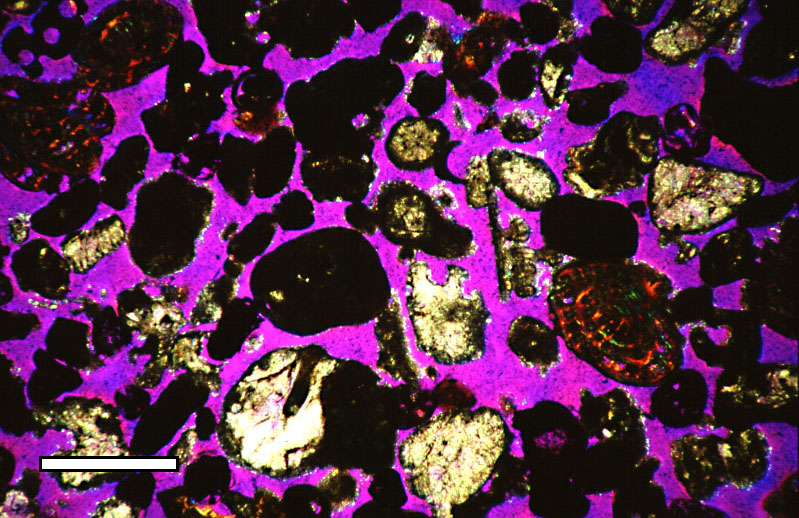|
Berman Flow
In fluid dynamics, Berman flow is a steady flow created inside a rectangular channel with two equally porous walls. The concept is named after a scientist Abraham S. Berman who formulated the problem in 1953. Flow description Consider a rectangular channel of width much longer than the height. Let the distance between the top and bottom wall be 2h and choose the coordinates such that x=0, \ y=0 lies in the midway between the two walls, with y points perpendicular to the planes. Let both walls be porous with equal velocity V. Then the continuity equation and Navier–Stokes equations for incompressible fluid become :\begin \frac + \frac &=0 \\ u\frac + v \frac & = - \frac \frac + \nu \left(\frac + \frac\right), \\ u\frac + v \frac & = - \frac \frac + \nu \left(\frac + \frac\right) \end with boundary conditions :u(x,\pm h) = 0, \quad \left(\frac\right)_=0, \quad v(x,0)=0, \quad v(x,\pm h) = V The boundary conditions at the center is due to symmetry. Since the solution is symmetric ... [...More Info...] [...Related Items...] OR: [Wikipedia] [Google] [Baidu] |
Fluid Dynamics
In physics and engineering, fluid dynamics is a subdiscipline of fluid mechanics that describes the flow of fluids—liquids and gases. It has several subdisciplines, including '' aerodynamics'' (the study of air and other gases in motion) and hydrodynamics (the study of liquids in motion). Fluid dynamics has a wide range of applications, including calculating forces and moments on aircraft, determining the mass flow rate of petroleum through pipelines, predicting weather patterns, understanding nebulae in interstellar space and modelling fission weapon detonation. Fluid dynamics offers a systematic structure—which underlies these practical disciplines—that embraces empirical and semi-empirical laws derived from flow measurement and used to solve practical problems. The solution to a fluid dynamics problem typically involves the calculation of various properties of the fluid, such as flow velocity, pressure, density, and temperature, as functions of space a ... [...More Info...] [...Related Items...] OR: [Wikipedia] [Google] [Baidu] |
Porosity
Porosity or void fraction is a measure of the void (i.e. "empty") spaces in a material, and is a fraction of the volume of voids over the total volume, between 0 and 1, or as a percentage between 0% and 100%. Strictly speaking, some tests measure the "accessible void", the total amount of void space accessible from the surface (cf. closed-cell foam). There are many ways to test porosity in a substance or part, such as industrial CT scanning. The term porosity is used in multiple fields including pharmaceutics, ceramics, metallurgy, materials, manufacturing, petrophysics, hydrology, earth sciences, soil mechanics, and engineering. Void fraction in two-phase flow In gas-liquid two-phase flow, the void fraction is defined as the fraction of the flow-channel volume that is occupied by the gas phase or, alternatively, as the fraction of the cross-sectional area of the channel that is occupied by the gas phase. Void fraction usually varies from location to location in the fl ... [...More Info...] [...Related Items...] OR: [Wikipedia] [Google] [Baidu] |
Navier–Stokes Equations
In physics, the Navier–Stokes equations ( ) are partial differential equations which describe the motion of viscous fluid substances, named after French engineer and physicist Claude-Louis Navier and Anglo-Irish physicist and mathematician George Gabriel Stokes. They were developed over several decades of progressively building the theories, from 1822 (Navier) to 1842–1850 (Stokes). The Navier–Stokes equations mathematically express conservation of momentum and conservation of mass for Newtonian fluids. They are sometimes accompanied by an equation of state relating pressure, temperature and density. They arise from applying Isaac Newton's second law to fluid motion, together with the assumption that the stress in the fluid is the sum of a diffusing viscous term (proportional to the gradient of velocity) and a pressure term—hence describing ''viscous flow''. The difference between them and the closely related Euler equations is that Navier–Stokes equat ... [...More Info...] [...Related Items...] OR: [Wikipedia] [Google] [Baidu] |
Berman
Berman is a surname that may be derived from the German and Yiddish phrase ( ‘bear-man’)https://dbs.anumuseum.org.il/skn/en/c6/e250048/Family_Name/BERMAN or from the Dutch , meaning the same. Notable people with the surname include: * Abba Berman (1919–2005), Polish-Israeli Rosh Yeshiva * Adolf Berman (1906–1978), Polish-Israeli activist and politician * Ahmet Berman (1932–1980), Turkish football player * Alan Berman (born 1943), American psychologist, psychotherapist, and suicidologist * Alexander Johan Berman (1828–1886), Dutch minister and literary critic * (1964-2017), Russian manager, whose work is connected with the oil and gas industry * Amy Berman (born 1954), circuit judge * (born 1963), American composer, multimedia artist, and music educator * Antoine Berman (1942–1991), French translator and theorist of translation * Arthur L. Berman (1935–2020), American lawyer and former Illinois state Representative * Bart Berman (born 1938), Dutch-Israeli pian ... [...More Info...] [...Related Items...] OR: [Wikipedia] [Google] [Baidu] |
Reynolds Number
In fluid mechanics, the Reynolds number () is a dimensionless quantity that helps predict fluid flow patterns in different situations by measuring the ratio between inertial and viscous forces. At low Reynolds numbers, flows tend to be dominated by laminar (sheet-like) flow, while at high Reynolds numbers flows tend to be turbulent. The turbulence results from differences in the fluid's speed and direction, which may sometimes intersect or even move counter to the overall direction of the flow (eddy currents). These eddy currents begin to churn the flow, using up energy in the process, which for liquids increases the chances of cavitation. The Reynolds number has wide applications, ranging from liquid flow in a pipe to the passage of air over an aircraft wing. It is used to predict the transition from laminar to turbulent flow and is used in the scaling of similar but different-sized flow situations, such as between an aircraft model in a wind tunnel and the full-size ... [...More Info...] [...Related Items...] OR: [Wikipedia] [Google] [Baidu] |
Taylor–Culick Flow
In fluid dynamics, Taylor–Culick flow describes the axisymmetric flow inside a long slender cylinder with one end closed, supplied by a constant flow injection through the sidewall. The flow is named after Geoffrey Ingram Taylor and F. E. C. Culick, since Taylor showed first in 1956 that the flow inside such a configuration is inviscid and rotational and later in 1966, Culick found a self-similar solution to the problem applied to solid-propellant rocket combustion. Although the solution is derived for inviscid equation, it satisfies the non-slip condition at the wall since as Taylor argued that the boundary layer that be supposed to exist if any at the sidewall will be blown off by flow injection. Hence, the flow is referred to as quasi-viscous. Flow description The axisymmetric inviscid equation is governed by Hicks equation, that reduces when no swirl is present (i.e., zero circulation) to :\frac - \frac \frac + \frac = -r^2 f(\psi) where \psi is the stream function The str ... [...More Info...] [...Related Items...] OR: [Wikipedia] [Google] [Baidu] |
Flow Regimes
Flow may refer to: Science and technology * Fluid flow, the motion of a gas or liquid * Flow (geomorphology), a type of mass wasting or slope movement in geomorphology * Flow (mathematics), a group action of the real numbers on a set * Flow (psychology), a mental state of being fully immersed and focused * Flow, a spacecraft of NASA's GRAIL program Computing * Flow network, graph-theoretic version of a mathematical flow * Flow analysis * Calligra Flow, free diagramming software * Dataflow, a broad concept in computer systems with many different meanings * Microsoft Flow (renamed to Power Automate in 2019), a workflow toolkit in Microsoft Dynamics * Neos Flow, a free and open source web application framework written in PHP * webMethods Flow, a graphical programming language * FLOW (programming language), an educational programming language from the 1970s * Flow (web browser), a web browser with a proprietary rendering engine Arts, entertainment and media * ''Flow'' (journal), a ... [...More Info...] [...Related Items...] OR: [Wikipedia] [Google] [Baidu] |

